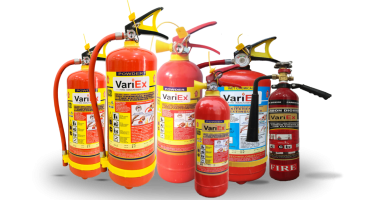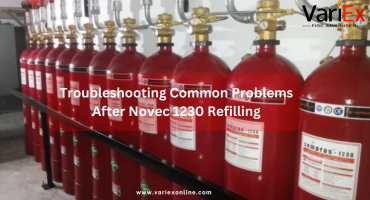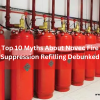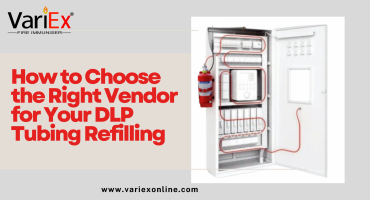![]()
Fire Immuniser
+91-7829629111
Email: info@variex.in
Varistor Technologies Pvt. Ltd.
Block-1, First Floor, Ardente Office One, Hoodi Circle, ITPL Main Road, Bengaluru, Karnataka 560048, IN
Compliance and Legal Standards for DLP Tubing System Refilling
Compliance and Legal Standards for DLP Tubing System Refilling
As fire suppression technology continues to evolve, Direct Low-Pressure (DLP) tubing systems have become a go-to solution for early fire detection and localized extinguishing. But as with any critical fire safety system, routine servicing and refilling are not just maintenance tasks—they're legal requirements. Ensuring your DLP tubing system is refilled in accordance with compliance and legal standards is essential to keeping your facility safe, operational, and free from regulatory penalties.
This comprehensive guide explores everything you need to know about the compliance framework, legal responsibilities, and industry standards involved in the refilling of DLP fire suppression tubing systems.
Why Compliance Matters in DLP Tubing Refilling
DLP systems are pressurized with fire suppression agents that must meet precise safety thresholds. An improper refill—whether due to incorrect pressure, expired agents, or unqualified service personnel—can cause serious consequences, including:
System failure during a fire
Violation of fire safety laws
Fines from regulatory authorities
Increased insurance premiums or claim denials
Compliance ensures your system works exactly as it should, when it matters most. It also protects your organization from legal liability and financial risk.
Core Legal and Safety Standards for DLP Tubing Refilling
Here are the primary national and international standards that govern the refilling and servicing of DLP systems:
1. NFPA 2001: Clean Agent Fire Extinguishing Systems
The National Fire Protection Association (NFPA) sets guidelines for clean agent systems, including refilling requirements, agent purity, and handling protocols. Key elements include:
Verification of agent type and quantity post-discharge
System integrity testing after refill
Annual inspections and five-year testing schedules
2. ISO 14520 Series
This global standard outlines performance and design requirements for gaseous fire suppression systems, including DLP systems. It specifies:
Agent concentration thresholds
Tolerances for pressure and flow
Safe handling and refill procedures
3. UL and FM Approvals
UL (Underwriters Laboratories) and FM Global set product safety benchmarks. For DLP systems, all suppression agents and refill components should be:
UL listed or FM approved
Traceable to manufacturer certification
Compatible with the DLP tubing infrastructure
4. EPA SNAP (Significant New Alternatives Policy)
If using clean agents like Novec 1230 or FM-200, compliance with EPA’s SNAP program ensures that only environmentally approved substances are used. Refilling with non-approved agents can lead to environmental and legal violations.
5. OSHA and Local Authority Guidelines
Employers must also comply with Occupational Safety and Health Administration (OSHA) protocols and local fire marshal codes, including:
Use of licensed professionals for hazardous work
Proper labeling and documentation
Worker safety and handling procedures
Legal Documentation Required After Refilling
Post-refill documentation is essential for legal compliance, insurance verification, and audit trails. Every refill service should provide the following:
| Document | Purpose |
|---|---|
| Refill Certificate | Confirms the system was properly refilled and tested |
| Pressure Test Record | Validates the correct operating pressure post-refill |
| Agent Batch Certificate | Verifies chemical purity and EPA/SNAP compliance |
| Service Log | Provides a complete record of the refill procedure |
| System Tag/Label Update | Shows date of refill and next scheduled inspection |
Retaining these documents is often required for up to 5 years, depending on your jurisdiction and industry.
Responsibilities of Facility Owners and Safety Managers
Legal compliance doesn’t rest solely on the vendor. Facility managers and fire safety officers have specific obligations, including:
Hiring licensed refill vendors
Verifying certifications and insurance
Scheduling timely inspections
Keeping refill and test records updated
Negligence in any of these areas can lead to civil liabilities, especially if the system fails during a fire.
Choosing a Vendor with Compliance in Mind
When selecting a vendor for your DLP tubing system refill, focus on their ability to comply with legal and technical standards. Ask questions like:
Are your technicians NFPA-certified?
Do you follow ISO 14520 refill protocols?
Can you supply agent batch certificates?
Are your agents EPA SNAP-approved?
Will I receive full compliance documentation after service?
A reputable vendor should be prepared to answer these questions transparently.
Compliance Challenges and How to Overcome Them
1. Using Non-Compliant or Expired Agents
Many facilities unknowingly refill systems with expired or unapproved agents due to cost-saving efforts. This not only invalidates the system warranty but also leads to regulatory fines.
Solution: Always request agent batch certificates and verify agent origin.
2. Unlicensed Technicians
Refills performed by non-certified technicians may not meet pressure tolerances, increasing the risk of failure.
Solution: Insist on NFPA-trained professionals and check for valid licenses.
3. Missing Documentation
Inadequate service records can create issues during audits or insurance claims.
Solution: Create a digital compliance log and request digital copies of all service paperwork.
4. Delayed Refill After Discharge
Failing to refill immediately after system discharge exposes the facility to fire risks and non-compliance.
Solution: Set internal protocols to trigger a refill within 24 hours of activation.
Compliance Checklist for DLP Tubing Refilling
Use this checklist to ensure full compliance before and after a DLP system refill:
Vendor holds NFPA or ISO certification
Suppression agent is UL/FM approved and SNAP-listed
Service performed by trained, licensed technicians
Pressure and integrity tests conducted post-refill
Agent batch and service records collected
System labeling updated with refill date
Facility logbook updated with all documents
Follow-up inspection scheduled
The Cost of Non-Compliance
Ignoring refilling standards can lead to:
Regulatory fines ranging from 427875 to 42,68,466
Temporary closure of operations due to fire safety violations
Voided insurance policies
Legal action in the event of fire-related injury or damage
By contrast, working with a compliant vendor and adhering to standards costs significantly less and ensures continuous fire protection.
Industry-Specific Compliance Tips
Data Centers
Use clean agents only. Regular testing of tubing pressure is mandatory.
Oil & Gas Facilities
Follow high-risk protocols including dual verification and gas detection integration.
Warehouses
Refill frequency may increase due to environmental contaminants; conduct quarterly checks.
Manufacturing Plants
Ensure agent compatibility with machinery. Document every refill for ISO audits.
Conclusion:
DLP tubing systems are only as effective as their last refill. Whether you're protecting a data center, warehouse, or laboratory, your obligation to meet compliance and legal standards is non-negotiable. Following these guidelines will not only keep your people and property safe but also ensure smooth operations, lower liability, and better relationships with regulators and insurers.
When in doubt, partner with vendors who prioritize legal compliance and transparency over shortcuts. In fire safety, doing things by the book is the only way to guarantee peace of mind.
Frequently Asked Questions
You risk violating EPA and NFPA standards, voiding your warranty, and facing fines.
Both. Vendors must perform legal refills, but the facility is responsible for hiring certified professionals and keeping records.
Ask for a batch certificate and check if the agent is UL listed and SNAP-approved.
Yes. Pressure and integrity testing are required after every refill to ensure system readiness.
In some jurisdictions, yes—especially in regulated industries. Always check with your local AHJ (Authority Having Jurisdiction).
Final Say
At VariEx.in and VariexOnline.com, we specialize in supplying and installing top-quality fire fighting systems and equipment. From fire extinguishers to advanced suppression systems, we offer comprehensive solutions tailored to your needs. Our experienced team ensures precise installation and maintenance for optimal safety.
Trust VariEx for reliable fire protection. Contact us online or call 7829629111 to learn more.
We specialize in manufacturing, supplying, and distributing a comprehensive range of fire fighting equipment, including state-of-the-art fire extinguishers. Read our most searched blogs and find interesting information on topics such as how to use a fire extinguisher, how to calculate fire fighting water tank capacity, fire extinguisher refilling, obtaining a Fire NOC, understanding fire fighting systems, types of fire protection systems, the fire hydrant system, and the fire sprinkler system. These resources provide essential knowledge for ensuring safety and compliance with fire safety regulations. Additionally, you can explore guides on the maintenance of fire protection equipment, the latest advancements in fire safety technology, and best practices for fire risk assessment and management.
Our expertise extends to fire alarm systems, fire hydrant systems, and fire suppression systems, including fire sprinklers. Each product meets rigorous international standards for reliability and performance, ensuring effective fire safety products tailored to diverse applications and industries. Additionally, we are providing Fire Extinguisher Refilling and AMC services to ensure ongoing maintenance and operational readiness of fire safety equipment.
"WHAT YOU CAN READ NEXT"
 Read more +24 November 2023 in Fire Extinguisher
Read more +24 November 2023 in Fire ExtinguisherWhat types of fire extinguishers are available for different fire classes?
 Read more +18 April 2025 in Fire Suppression
Read more +18 April 2025 in Fire Suppression





